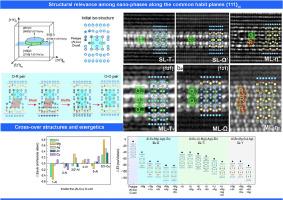沿共同习性面{111}的纳米相之间的结构相关性及其对跨界铝合金设计的影响
IF 8.3
1区 材料科学
Q1 MATERIALS SCIENCE, MULTIDISCIPLINARY
引用次数: 0
摘要
众所周知,不同系列铝合金中的Ω、T1、Y、η'和η纳米相都是沿着主要滑移面{111}Al析出的。因此,它们在多元素交叉铝合金中的析出可能非常复杂。在这项工作中,我们将原子分辨率 HAADF-STEM 和第一原理计算结合起来,全面研究了它们在一组模型铝合金中的原子结构和能量学。我们的研究结果表明,它们最初都倾向于形成由沿{111}方向的等结构(Al,Cu)O-单元组成的二维层状结构,而它们的进一步演变则敏感地取决于合金成分。与镁和/或银合金化可稳定铝-铜-镁(-银)合金中的 O 单元,使其形成单层 Ω(SL-Ω 或 Ω')。与锂合金化可稳定铝-铜-锂合金中的 O 单元,形成 SL-T1。与镁和锌合金化可稳定 O 原子,在铝-锌-镁-铜合金中形成 SL-Y。对于镁+锌和锂含量较低的交叉铝合金,O-单元将增长为 O-O 对,从而诱发 SL-Ω (Ω') → 多层 (ML) -Ω 转变。增加锂含量有助于 SL-T1 持续增长或转化为 O-O'-O 堆叠的 ML-T1。这两种机制都会抑制 ML-Ω。对于镁+锌含量较高的交叉铝合金,O-单元增长为 O-R 对,并进一步增长为 R-R-1 对,从而在铝-锌-镁-铜(-镁)(-锂)合金中诱导出 SL-Ω/T1/Y → η' → η 的转变,这种转变强烈优于 Ω 和 T1。这些结果可以从根本上解释各种实验观察结果,并为交叉铝合金中的竞争性析出提供了许多深刻的视角。本文章由计算机程序翻译,如有差异,请以英文原文为准。

Structural relevance among nano-phases along the common habit planes {111} and its implications for the design of cross-over Al alloys
Ω, T1, Y, η' and η nano-phases in different series Al alloys are known to all precipitate along the major slip planes {111}Al. Their precipitation in multi-element cross-over Al alloys could thus be very intricate. In this work, atomic resolution HAADF-STEM and first-principles calculations were combined to comprehensively investigate their atomic structures and energetics in a set of model Al alloys. Our results revealed that they all tend to initially form a 2D layered structure consisting of an isostructural (Al,Cu) O-unit along the {111}, and that their further evolution sensitively depends on alloy composition. Alloying with Mg and/or Ag stabilizes the O-units to form a single-layer Ω (SL-Ω or Ω') in Al-Cu-Mg(-Ag) alloys. Alloying with Li stabilizes O-units to form SL-T1 in Al-Cu-Li alloys. Alloying with Mg and Zn stabilizes O-units to form SL-Y in Al-Zn-Mg-Cu alloys. For cross-over Al alloys with a low Mg+Zn and low Li content, O-units would grow into O-O pairs to induce the SL-Ω (Ω') → multi-layer (ML)-Ω transformation. Increasing the Li content helps SL-T1 grow continuously or transform into ML-T1 with an O-O'-O stacking. Both mechanisms take actions to suppress ML-Ω. For cross-over Al alloys with high Mg+Zn content, O-units grow into O-R pairs and further into R-R−1 pairs, inducing the transformation of SL-Ω/T1/Y → η' → η in strong preference over Ω and T1 in Al-Zn-Mg-Cu(-Ag)(-Li) alloys. These results can fundamentally explain diverse experimental observations and provide many profound perspectives on the competitive precipitation in cross-over Al alloys.
求助全文
通过发布文献求助,成功后即可免费获取论文全文。
去求助
来源期刊

Acta Materialia
工程技术-材料科学:综合
CiteScore
16.10
自引率
8.50%
发文量
801
审稿时长
53 days
期刊介绍:
Acta Materialia serves as a platform for publishing full-length, original papers and commissioned overviews that contribute to a profound understanding of the correlation between the processing, structure, and properties of inorganic materials. The journal seeks papers with high impact potential or those that significantly propel the field forward. The scope includes the atomic and molecular arrangements, chemical and electronic structures, and microstructure of materials, focusing on their mechanical or functional behavior across all length scales, including nanostructures.
 求助内容:
求助内容: 应助结果提醒方式:
应助结果提醒方式:


